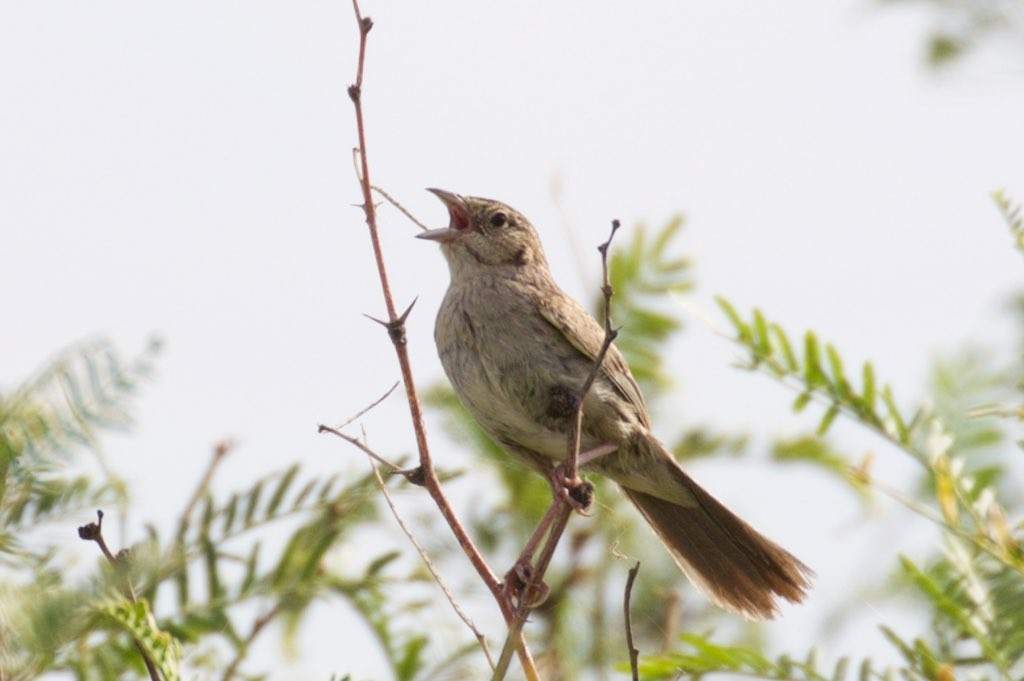Cassin's Sparrow
A species of Sparrow Scientific name : Peucaea cassinii Genus : Sparrow
Cassin's Sparrow, A species of Sparrow
Botanical name: Peucaea cassinii
Genus: Sparrow
Content
Description General Info
Description
The sparrow has a long tail, gray-brown with white corners, and has dark marks on the back and sides. The species resembles Botteri's sparrow because of its size and marks, but Boterri's sparrow is a weaker shade of gray. The best way to tell the differences between the two is the song of Cassin's sparrow. Both the males and females are the same shade of gray and are 5 to 6 inches, although males are bigger. The Cassin's sparrow is a fairly large, plain, grayish sparrow that lacks conspicuous markings. In flight, the long, roundish tail is obvious and the white tips of the tail feathers are sometimes apparent. This species is most easily identified by its distinctive song and dramatic skylarking behavior during the breeding season. Although often characterized in the literature as secretive and difficult to observe when not singing, Schnase (1984) observed that Cassin's sparrows readily accommodated the presence of an observer, especially early in the breeding season. 
Size
15 cm (6 in)
Nest Placement
Ground
Clutch Size
3 - 4 eggs
Incubation Period
1 - 2 broods
Number of Broods
9 - 11 days
Nestling Period
7 - 9 days
Feeding Habits
Cassin's Sparrow are ground feeders commonly eating seeds and insects with a winter diet predominantly consisting of seeds. Their summer diet includes grasshoppers, crickets, caterpillars, ants, and spiders. Known seeds consumed are from chickweed, woodsorrel, sedge, and switchgrass.
Habitat
Cassin's Sparrow predominantly inhabit arid grasslands with a scattering of shrubs, yucca, and low trees, embracing environments from open slopes to mesquite grasslands. These birds are adapted to a range of altitudes up to approximately 7,000 feet, thriving in climates that support grasses, forbs, and cacti. Vegetation types such as oak, acacia, mesquite, hackberry, sand sagebrush, rubber rabbitbrush, greasewood, and prickly pear are also integral to their preferred habitats. Cassin's Sparrow utilize native grasslands, typically avoiding cultivated fields, dense brush, and shrubbery.
Nest Behavior
The female cassin's Sparrow solely constructs the nest and lays eggs. Post-construction, egg-laying and both parents' involvement in nurturing the young follow.
Nest Characteristics
Cassin's Sparrow's nest is a ground-level loose cup made of grasses and weeds, lined with hair, fine grass, and roots. It averages 3.4 inches in width and is placed in shrubs or grass clusters.
Dite type
Insectivorous
General Info
Feeding Habits
Bird food type
Bird Feeder Type

Platform
Behavior
Cassin's Sparrow are inconspicuous except when males perform their impressive song flights, ascending to significant heights before descending with a tranquil melody. They exhibit regional variation in courtship, sometimes forming pairs in spring or before males vocalize. Territorial, cassin's Sparrow engage in chase flights and perform courtship displays with fluttering wings, spread tails, and buzzy calls. Rarely confrontational, they maintain territories up to nearly 13 acres without forming colonies. Both sexes contribute to incubation and rearing. Post-fledging, juveniles may congregate locally, while adults retain territories year-round.
Species Status
Not globally threatened.
Scientific Classification
Phylum
Chordates Class
Birds Order
Perching birds Family
New world sparrows Genus
Sparrow Species
Cassin's Sparrow 